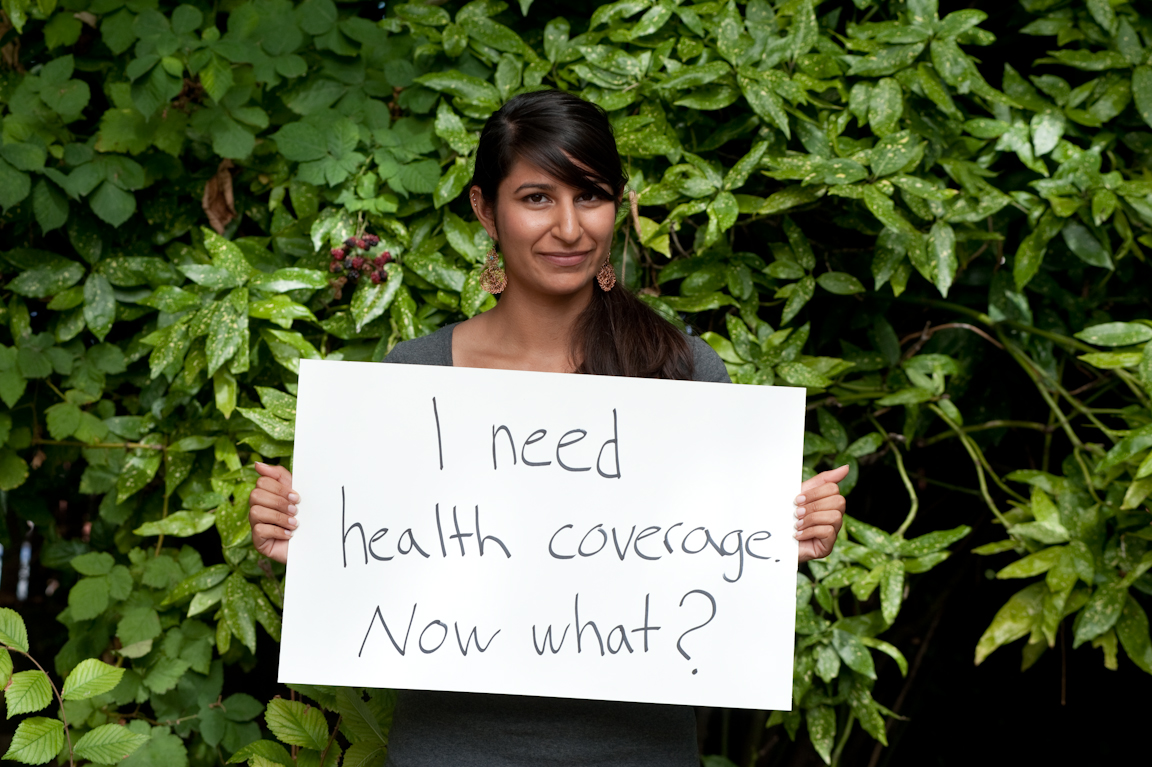
SO YOU NEED HEALTH INSURANCE. NOW WHAT?
Read the Health Insurance 101 guide below, or download the PDF here.
Having the facts can make all the difference when it comes to health insurance. To make the most of new choices, protections and financial help, you need good information. This guide can help you find quality coverage that won’t break the bank.
Downloads
So, You Need Heath Insurance. Now What?
North Carolina Health Insurance 101
Having the facts can make all the difference when it comes to health insurance. To make the most of new choices, protections and financial help, you need good information. This guide can help you find quality coverage that won’t break the bank.
Contents
3. What are my Options? Where to Look for Health Coverage
4. What Plan is Right for me? Making the Most out of the Health Insurance Marketplace
5. What are my Rights? Getting a Fair Shake from your Insurance Company

1. Do I Need Insurance?
Dealing with health insurance as a young person can be tricky. You might be uninsured, or could be about to lose coverage through your parents’ or college’s health plan, but aren’t sure what to do next. Looking for insurance raises all kinds of questions: Can I afford it? What’s covered if I get sick? Where do I look to find a decent plan?
But let’s face it: Not getting covered is even worse. If you have an accident or a serious illness, it could mean getting stuck with huge medical debt or going broke. A single visit to the emergency room for an unexpected health situation can run into the thousands or tens of thousands of dollars. And, as of January 2014, most people must get covered or pay a fee.
The good news is that with the right facts and resources, you can make intelligent and informed health insurance choices. And, with the new health insurance marketplace, it’s easier to compare plans and find coverage that fits your budget and helps keep you healthy.
2. What’s Changing?
The main pieces of the Affordable Care Act, or “Obamacare,” go into effect. Here are some of the highlights:
New Options: As of October 2013, the Health Insurance Marketplace will help you compare options, find out about financial help, and sign up for coverage. Find out more at Healthcare.gov or by calling (800) 318-2596 TTY: (855) 889-4325.
No More Pre-Existing Condition Denials: Effective January 2014, health insurance companies can no longer deny coverage or hike your rates due to having a pre-existing health condition.
An End to Gender Discrimination: Charging women more than men for coverage is now against the law.
Financial Help Kicks In: If your income is less than about $46,000 for an individual, or $94,000 for a family of four, you can get help paying for the cost of coverage if you buy it on the marketplace. In many states, citizens and lawfully admitted immigrants earning less than about $16,000 a year for a single person and $32,500 for a family of four can get free or low-cost coverage through the Medicaid program.
Everyone Must Get Covered: To keep health insurance premiums from rising more than they should, everyone needs to pull his or her weight and get covered. If people only buy coverage when they get sick, it drives up costs for everyone. So, as of January 2014, all who can afford it must get covered or pay a fee.
Learn more about the health care law at hhs.gov/healthcare.
3. What are my Options?
Where to Look for Health Insurance
Getting coverage for the first time can be confusing. But with new options and better tools to compare plans, you can succeed. Here’s where to look, whether you are finding coverage for the first time, or if your situation has changed and you need to get covered again.
Parents’ Plan
If you want good health coverage and you are not yet 26, your first call should be to your parent or guardian. The Affordable Care Act requires most health insurance plans to allow you onto your parent’s or guardian’s coverage until your 26th birthday as long as they have a family plan.
If your parents are already carrying a family plan, they will not be required to pay anything extra to cover you. If they have a plan that only covers themselves or themselves and a spouse, they will have to purchase a family plan at the next open enrollment period. Even then, the cost will likely be far less than paying for their plan and a separate policy for you.
To determine when and whether you may be eligible for your parents’ coverage, contact the insurance company.
Coverage Through Your Job
More than half of all Americans receive their health coverage through their employer-provided plan, and you may have a chance to be one of them.
So when considering a job, find out about the health insurance benefits. And if you have a job now, stop by your employer’s human resources or personnel office to see what health insurance benefits are available, if any, and find out how to sign up.
Student Health Plan
Many colleges and universities offer health insurance plans to their students. Generally, these plans are available only to students, but some allow students taking time off from school to maintain their coverage, or keep their coverage for a limited period of time after graduation. Find out about plans your school might offer at the student health office.
One thing to watch out for is that often, these plans are designed for healthy people who don’t need much care. See more under the section “What are the costs?” for tips on figuring out what plan is right for you.
The Health Insurance Marketplace
Shopping for health insurance can be challenging. But with the new online health insurance marketplace, chances are getting better that you can find a good plan that fits your budget.
At the Health Insurance Marketplace, you can see all your options and enroll. Information about insurance plans is written in plain language, and all the plans have to cover a good set of benefits – including doctor visits, hospitalizations, maternity care, emergency room care, prescription drugs and more. No insurance plan can deny you or charge you more because of a pre-existing condition.
If you buy a plan on the marketplace, you might qualify for financial help to make coverage more affordable.
Find out more at Healthcare.gov, or by calling (800) 318-2596 TTY: (855) 889-4325.
Medicaid and the NC Children’s Health Insurance Program (CHIP)
North Carolina’s Medicaid is a public program that provides health insurance for some low-income people, families and children, pregnant women, the elderly, and people with disabilities.
If you’re 18 or younger, or have children of your own, you may want to check out the the Children’s Health Insurance Program (CHIP) in North Carolina, NC Health Choice for Children. It provides low-cost health coverage to children in families that earn too much to qualify for Medicaid.
Many states are expanding Medicaid so that it can cover people with higher incomes than before. If you didn’t qualify before, you might now. As of October 2013, you can find out if you qualify for these programs by filling out an application at the Health Insurance Marketplace.
4. What Plan is Right for me?
Making the Most out of the Health Insurance Marketplace
4.2 Find out about Financial Help
4.4 Compare Plans Side By Side
4.5 What Health Care Providers Can You See?
4.6 How Does the Quality Stack Up?
4.7 Get Expert Help Comparing Plans and Signing Up
At the Health Insurance Marketplace, different plans’ costs and benefits are written in plain language. And you’ll be able to compare them side-by-side.
ESSENTIAL BENEFITS
All health insurance plans offered in the Health Insurance Marketplace have to offer the same set of core benefits and some may offer additional benefits. These core benefits include:
- Hospital outpatient and inpatient care
- Emergency services
- Maternity and newborn care
- Mental health and substance use disorder services, including behavioral health treatment such as counseling
- Prescription drugs
- Services and devices to help people with injuries, disabilities, or chronic conditions gain or recover mental and physical skills.
- Chronic disease management
- Pediatric services
PREVENTIVE CARE
Insurance plans must cover a set of preventive services without any out-of-pocket costs for you. See the full list of general preventive services, preventive care for women, and preventive care for children.
Find Out About Financial Help

Between college loans, living expenses, and credit card debt, it can be tough to find a way to pay for health insurance. The good news is that there may be financial help available to make coverage more affordable for you.
Many people are able to pay on a sliding scale, or even qualify for free or very low-cost coverage. To find out what savings you qualify for, fill out the application at the Health Insurance Marketplace. If you run into questions, remember that you can always get help online, on the phone or in-person.
There are three kinds of financial help available, depending on your income and family size:
LOWER MONTHLY HEALTH CARE PREMIUMS
You may qualify for a subsidy that reduces your monthly premium amount. The amount you save off your premium depends on your income and family size.
Many people will qualify for some level of this tax credit. For example, you’ll see lower premiums if your income is up to about $46,000 for an individual, $62,000 for a family of two, or $94,000 for a family of four.
LOWER OUT-OF-POCKET COSTS
You may also be able to pay less for “out-of-pocket costs” like co-pays and deductibles, which you pay for at the time you receive medical care. Many people will qualify for these lower costs.
FREE OR LOW-COST COVERAGE
You, or your children if you have any, may qualify for Medicaid or NC Health Choice for Children – two programs outlined earlier in this guide. When you fill out your application at the Health Insurance Marketplace, you’ll find out if you and your family qualify.
What are the Costs?

Once you’ve narrowed down your options to several plans, take a look at the specific costs of each plan. It’s important to consider not only the monthly premium, but the potential out-of-pocket costs as well. That way, you can get a sense of the total cost you might face over the course of a year. The specific out-of-pocket costs to look at are co-pays, deductibles, and co-insurance. You’ll also want to make special note of the out-of-pocket maximum. For definitions of these terms, see the section on “Health Insurance Basics.”
Here’s a simple formula to see what you could have to pay in a year, in a worst-case scenario if you have a major illness or accident:
(Monthly Premium x 12 months) + Out-of-Pocket Maximum = Worst-case scenario yearly cost
Compare Plans Side by Side
At the Health Insurance Marketplace, you can compare plans based on a number of factors. You can look at premiums and out-of-pocket costs, and see which health care providers and hospitals are available in each plan. In some states, you can already compare quality ratings of the different plans, and in others the quality rating will be added in future years.
BRONZE, SILVER, GOLD AND PLATINUM
In the past, it was practically impossible to compare insurance plans “apples to apples,” with seemingly infinite combinations of premiums, co-pays, deductibles, annual coverage limits, co-insurance levels, and out-of-pocket maximum amounts.
In the marketplace, you can take advantage of the fact that the insurance plans have been neatly sorted into categories so you can compare them more easily. The categories are Bronze, Silver, Gold and Platinum.
The categories are not based on the quality of care, or the amount of care you can receive. They are based on how much of your medical costs you pay, and how much the insurance company pays
As a general rule, the higher the monthly premium, the lower your out-of-pocket costs will be if you need care.
Platinum plans will generally have the highest premiums, but if you need care, you’ll pay less in out-of pocket costs. Bronze plans will generally have lower premiums, but you’ll pay more in out-of-pocket costs if you need care.
If you think you’ll need a lot of care in the year ahead, it might make sense to pay a somewhat higher monthly premium and get a Gold or Platinum plan, and know that you’ll face lower out-of-pocket costs when you receive care.
On the other hand, if you don’t think you’ll need much care, you may want to pay a lower monthly premium and get a Bronze or Silver plan, and risk the chance that you might get hit with higher out-of-pocket costs if you have an unexpected illness or accident.
CATASTROPHIC PLANS
In addition to the Bronze, Silver, Gold and Platinum plans, if you’re under 30, or if you otherwise qualify by having a limited income that makes other coverage unaffordable, you may buy a “catastrophic plan.”
These plans have lower premiums and they cover preventive care and three primary care visits per year with no co-pay. But if you need more care, you’ll face significant out-of-pocket costs. That’s because a catastrophic plan requires you to pay 100% of the cost of your medical care until you’ve paid a certain amount, often several thousand dollars.
These plans protect you from worst-case scenarios where you’d otherwise be on the hook for medical care costing tens or hundreds of thousands of dollars, hence the name “catastrophic.” It’s also important to note that if you choose a catastrophic plan, you won’t be able to qualify for financial help through the marketplace.
What Health Care Providers Can You See?
When you are comparing plans, take advantage of the fact that each plan will include a list of health care providers. This is the plan’s “provider network.” If you visit a provider that isn’t part of this network, you’ll pay higher costs, so if you already have a doctor, check to see if they are included in the plan you are considering.
Different types of insurance plans have different rules about whether you can get care outside of their provider network and still get the cost covered, and at what cost:
HEALTH MAINTENANCE ORGANIZATION (HMO)
An HMO typically only covers care if you visit a provider in their provider network. You may be on the hook for the full cost of care if you use a health provider outside of the network. In addition, if you want to see a specialist in the network, you may need to get a referral from your primary care provider.
PREFERRED PROVIDER ORGANIZATION (PPO)
A PPO covers care from providers both inside and outside the network. However, if you us a provider outside the network, you’ll pay higher out-of-pocket costs for that care. You can see a specialist inside or outside the network without a referral.
How Does the Quality Stack Up?
Unfortunately, when it comes to health care, cost rarely tells you anything about quality. Few things are more important than your health, but for a long time there has been too little information about health care safety and quality available for consumers.
Now, that’s changing. In many states, the new marketplace includes tools to help you compare the quality of insurance plans and their provider networks. In other states, this information will become available in future years.
GREAT RESOURCES
Health Plan Report Card
Check out quality ratings of the health insurance plans you are considering and compare them head-to-head on things like how well they help people stay healthy, get better when they’re sick, and manage chronic illness. This site is run by the National Committee for Quality Assurance.
Physician Compare
Find out which physicians and other health care providers take part in several important quality programs. In the future it will also include quality ratings and information about participation in other quality programs. The site is run by Medicare.
www.medicare.gov/physiciancompare
Hospital Compare
Find out how hospitals in your area rate on a variety of quality, safety, and patient satisfaction measures, and how they compare to the average across the state and across the nation. This is also part of the official U.S. government site for Medicare.
www.medicare.gov/hospitalcompare
Get Expert Help Comparing Plans and Signing Up

At the Health Insurance Marketplace, you can apply for coverage online, by mail, or in-person, and get help from a specially trained person to guide you through the process.
In person: People are available in communities across the state to help you apply and understand your options. Find them by visiting the website or calling the toll-free number below. You can also use the “Local Help” tool at LocalHelp.healthcare.gov to locate consumer assistance destinations in your area.
Online: Healthcare.gov
Toll-free: (800) 318-2596 TTY: (855) 889-4325
5. What Are My Rights?
Getting a Fair Shake from Your Insurance Company
Whether you’re just beginning the search for health insurance or already have coverage, you should be aware of your rights and the rules insurance companies must abide by under the law.
1. The right to stay on your parents’ family health insurance plan until age 26.
2. The right to coverage that cannot be dropped when an unexpected condition or accident makes your care expensive.
3. The right to an appeal if coverage for needed care is denied by your insurer.
4. The right to information about the cost of insurance and the quality of insurance benefits so that you can choose the plan that works best for you.
5. The right to choose your own primary care doctor or pediatrician and to see an OB/GYN without a referral.
6. The right to emergency care when and where you need it without huge out-of-network costs.
7. The right to a rebate if your insurer spends less than 80% of premium dollars on care.
8. The right to free preventive care to keep you healthy and your health care costs down.
9. The right to get covered, even if you have a pre-existing health condition.
If your insurer fails to respect your rights, contact the state insurance commissioner. Go to www.naic.org/documents/members_membershiplist.pdf for details on how to report insurance company abuses. You can also contact the federal Department of Health and Human Services by emailing [email protected].
6. Health Insurance Basics and Key Definitions
If you get sick or are injured in an accident, hospital and doctor bills can quickly exceed your ability to pay.
One way people have dealt with this is by buying health insurance policies that ensure they can get health care without paying for everything out of pocket. Every month, individuals—and in many cases their employers, too—pay a certain amount of money to an insurance company to purchase coverage (also called a health insurance plan or policy). That coverage means that if you get sick or have an accident, the insurer agrees to cover some or most of the expenses.
Paying for Insurance and Medical Care: Key terms
Premium: The amount charged to keep you on your insurance plan, usually quoted as a monthly price. For employer-provided insurance, the premium is usually shared between the employer and the employee.
Cost-Sharing (or out-of-pocket costs): In addition to premiums, many plans use other ways to share costs for medical expenses between the insurance company and the patient. There are three types of cost sharing: “co-pays,” “deductibles,” and “co-insurance.”
Co-Pay (or co-payment): A flat amount you pay when you get medical care. For example, you may have a $20 co-pay for a visit to a primary care doctor and a $25 co-pay for prescriptions.
Deductible: The amount which you must pay yourself before your insurance covers any costs. For example, a plan with a $1,000 deductible would require you to pay for your first $1,000 of medical care each year before the insurance company would cover any portion of the cost. Office visits are usually exempt from the deductible, meaning you would just pay the co-pay amount.
Co-Insurance: This cost-sharing method usually kicks in after you hit your deductible. It requires a patient to pick up a certain percentage of the cost of a procedure while the plan covers the rest. For example, a plan with 80/20 hospital co-insurance will cover 80% of the cost of your hospital stay, and 20% of the costs will be your responsibility.
Out-of-Pocket Maximum: The maximum amount you could have to pay in a year in out-of-pocket costs. Once you’ve paid this amount in the year, your insurance covers 100% of the costs of any additional medical care.
Main Types of Health Coverage
GROUP COVERAGE
Health insurance plans provided by a company, government agency, or union. Rather than covering one person or one family, these plans cover large groups of people. In most cases, employers pay a portion of the cost of the premium.
INDIVIDUAL COVERAGE
This is coverage bought by the individual, not the employer, for him or herself and his or her family. Effective 2014, many people with individual coverage will qualify for financial help paying for premiums and out-of-pocket costs.
PUBLIC COVERAGE
Coverage paid for with federal or state dollars. For example:
Medicaid Program: Government health care that provides health coverage for some low-income people, families and children, pregnant women, the elderly, and people with disabilities. The programs follow federal guidelines, but vary depending on what state you live in.
Children’s Health Insurance Program (CHIP): Similar to Medicaid, this is a government program that provides low-cost health coverage to children in families that earn too much for Medicaid.
Medicare: A federal government program that provides health insurance to people over age 65 and to some people with disabilities.
7. Tell Us What You Think
Click here to tell us about your experience finding health insurance. We want to hear how it went, so we can keep working to make it better.
Our organization and many others have worked for years to lower the cost of health care and give consumers better choices and more control. The new options and tools consumers have now, including the Health Insurance Marketplace, all mark a key milestone in this effort.
But we still have more progress to make if we’re to really make health care work. Going forward, we’ll make the case for ongoing improvements to ensure the new marketplace meets its potential to boost competition, reduce costs and improve quality. And we’ll work to strengthen other key consumer protections aimed at cutting waste and improving care.
8. Get Involved
Your friends likely have the same questions as you about health insurance. Many people are unaware of the new coverage options. You can help make a difference by educating your friends and peers by sharing this guide with them.
In addition, there are internships and volunteer opportunities available to work on the Health Insurance 101 public education campaign to help get the word out to even more people. Learn about internships: www.studentpirgs.org/internships.
9. About this Guide
AUTHORS
Laura Etherton
Mike Russo
The authors bear responsibility for any factual errors. The views expressed in this guide are those of the author, and do not necessarily reflect the views of our funders.
ABOUT NCPIRG EDUCATION FUND
With public debate around important issues often dominated by special interests pursuing their own narrow agendas, NCPIRG Education Fund offers an independent voice that works on behalf of the public interest. NCPIRG Education Fund, a 501(c)(3) organization, works to protect consumers and promote good government. We investigate problems, craft solutions, educate the public, and offer meaningful opportunities for civic participation.
This publication was made possible in part through generous support from the Robert Wood Johnson Foundation.
![]()
Some Rights Reserved: NCPIRG Education Fund issues this guide under a Creative Commons Attribution-NonCommercial-NoDerivs 3.0 Unported License. You are free to copy, distribute, or display the work for noncommercial purposes, with attribution. More information about this Creative Commons license.
Topics
Find Out More


Medical Bills: Everything you need to know about your rights

Did your insurance deny your health care claim? How to appeal.
